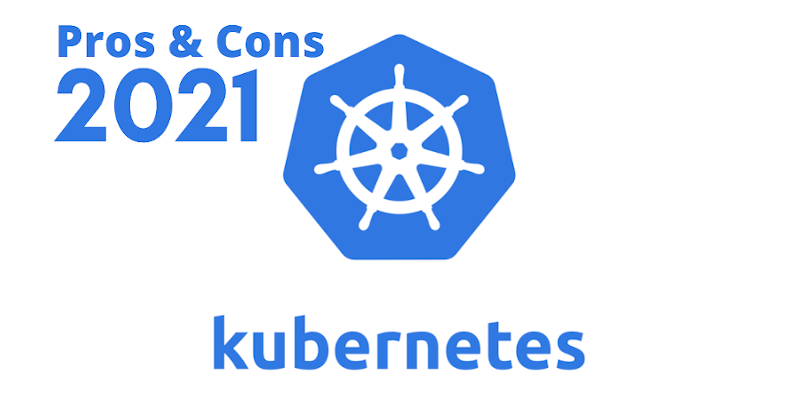Since open-sourced by Google, Kubernetes has become the de-facto standard to container orchestration, drawing us closer to an ideal DevOps world.

Enterprises are adopting Kubernetes to increase agility, shorten software delivery cycles, and accelerate digital transformations. They, of course, want to harness the full potential of Kubernetes but for a technology that is still relatively young, these benefits don’t come without their own set of tradeoffs.
In a nutshell, it is about identifying those challenges to make the most of the technology.
What would be the possible advantages and drawbacks of adopting Kubernetes next year? We explore below.
Production Deployments vs. Security Concerns
Production deployments are getting stronger
With all sorts of attention Kubernetes is receiving, it’s easy to forget how relatively young the technology is. But thanks to a massive community, Kubernetes is maturing at a pace unheard of before.
Enterprises are hence moving their production workflows to this orchestration platform, driving its adoption at an all-time high.
In VMWare’s State of the Kubernetes 2020 survey, half of the participants are running at least 20 Kube clusters or around half of their containerized workloads on Kubernetes.
Initial containerization adopters who relied on a container orchestration tool other than k8 (a.k.a. Kubernetes) have already learned their lessons and are looking for the first exit.
Simply put, they want to adopt Kubernetes, and they want to do it now.
The platform, no doubt, had tide flowing in its direction with K8 production deployments reaching all-time highs.
But security concerns are inhibiting the momentum
Early adopters in enterprise space rushed to adopt Kubernetes and associated technologies for their obvious advantages while overseeing the tradeoff—application security.
For a DevOps-centric organization, there are too many advantages to see through: faster development cycles and quicker deployment schedules, bug fixes and patches, accelerated deliveries, and competitive advantage.
Enterprises have finally realized that despite the extensive list of benefits, they cannot realize the full potential of Kubernetes with security threats looming around.
According to StackRox’s recent report, 44% of the IT decision-makers surveyed admitted to delaying an application release due to potential security concerns. This is indeed a worrisome figure.
After all, watching nearly half of participants slowing down or halting Kubernetes deployment into production because of one or more security concerns is bad even in 2020.
One might even wonder – what is the whole point of Kubernetes if it can’t be taken into production? No doubt, the situation is getting better as increasingly more enterprises are beginning to entrust Kubernetes in production.
2021 is off to a great start already.
Multi-Cloud Deployments vs. Vendors Lock-Ins

Multi-cloud deployments are on a rise
Businesses seem to have learned the potential limitations of running all of their Kubernetes instances or managed Kubernetes clusters on a single cloud vendor.
Enterprises are more likely to adopt a multi-cloud approach as they mature with their Kubernetes strategies and add more details to it.
StackRox’s other recent survey indicates that 35% of its participants are filling their Kubernetes approaches to multiple public clouds.
If we’re discussing cloud-only container deployments (keeping hybrid aside), 27% of respondents are running Kubernetes on multi-clouds while 13% are on a single cloud.
But Vendor lock-ins remain a reality
Although the multi-cloud approach to Kubernetes deployments is set to take off, a single cloud approach is still the dominant force.
After all, multi-cloud deployments grew year over year but still trail behind single-cloud deployments by a sizable margin. Going back to StackRox’s survey, 35% of its participants said yes to multiple public clouds, while 51% of them were running their Kubernetes deployments on a single cloud.
At a time when an open-source world seems like a reality with the world’s tech giants like Microsoft strongly vouching for the movement, vendor lock-ins might threaten to limit the full potential of what new possibilities and developments in cloud computing have to offer.
Some can argue that while cloud vendors are making big promises in this direction, there is still a little to be seen in action. For now, a single cloud approach seems like a safe bet with large consequences albeit a few organizations are at work to make cloud interoperability a reality.
Multiple Stakeholders vs Complex Decision Making
Kubernetes Benefits Multiple Stakeholders
Kubernetes delivers clear benefits for several groups of stakeholders. For instance, it is loved by operations and development teams alike. Even security and testing guys look at it with great promises.
Resource efficiency is a big responsibility for Ops while every developer dreams about committing each build and see it in action. Security teams wish to see DevSecOps become mainstream, and quality analysts want ‘testing’ to keep moving ‘left’.
Kubernetes is, perhaps, the only solution that operations, development, security, and testing teams can agree on. Again, committing faster builds, controlled IT spending, top-notch application security and continuous testing is the holy grail of the cloud era.
But decision-making gets more complicated
Naturally, as the number of stakeholders increases, so does the complexity of decision-making. Going back to VMWare’s survey, 40% of respondents blamed internal alignment as a hindrance when choosing a Kubernetes distribution.
Unmistakably, k8 brings operators, developers, and other stakeholders together, but for many organizations, it is a little more complicated. When a business doesn’t make amendments at the structural and cultural level, these problems tend to arise.
In 2021, businesses might tend to increasingly seek consulting partners with Kubernetes expertise to streamline decision-making and offset the experience gap within their IT environments.
On-Premise Deployments vs Resources Gap
On-premises Deployments Dominate Kubernetes
While Kubernetes is made to sound synonymous with cloud-native operations, its deployments in major enterprises are not public clouds.
Despite so many iterations, Kubernetes remains as flexible of technology as it was five years ago. It runs on the public cloud as efficiently as on hybrid or an on-prem data center.
For enterprises that prefer to avert risks that they might be exposed to on the public cloud, Kubernetes presents itself as an ideal alternative when deployed on existing infrastructure until ready to move.
Put simply, Kubernetes will deliver you the same agility regardless of where you have decided to deploy it.
When discussing containerization, Toptal’s recent article on service meshes as a tool might be a useful read.
Kubernetes is a victim of its own success
Kubernetes is a victim of its own success. It’s growing faster than the resource and skill pool can keep up.
And with Kubernetes becoming the enterprises’ darling, the resource gap will only widen. On top of the internal skills shortage, the barrier to entry is another letdown.
All in all, Kubernetes presents a steep learning curve, making challenging for organizations to train inexperienced staff.
Despite these hurdles, more enterprises are likely to make a jump to managed Kubernetes services from their in-premise location to overcome the resource gap in 2021.
Regardless of what the next year brings us, one thing is sure: as a powerful and disruptive tool, Kubernetes indeed opens up a world of possibilities for organizations small and large in scale alike.
What’s your cloud strategy for 2021?
Our cloud experts are here to help you select the most suitable deployment architecture for your migration.
With our tailored support and a variety of solution-focused tools, Clouve has got you covered from A to Z when it comes to all of your cloud needs!
Try it. Deploy your first ticket free
